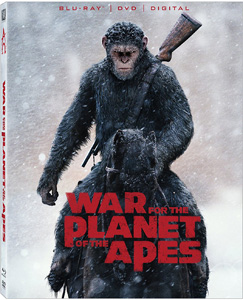Watching “War for the Planet of the Apes” – now available via Redbox and streaming – is like seeing a movie from the future. Every scene has an ape in it; there’s never a sense that the filmmakers are being frugal with the special effects, but at the same time, they aren’t showing off. While I know the trick is achieved with motion-capture and computer animation, there are moments when I wondered if actual chimpanzees were used (They were not, the web tells me).
The fact that technology now allows for a full movie of believable CGI apes is something a viewer can appreciate without dwelling on it, because “War for the Planet of the Apes” is absorbing for how it illustrates the complex insanity of alliances and enemies and forgiveness and vengeance and murder and survival. “Dawn of the Planet of the Apes” showed a human hero and an ape hero working together to stave off a massive conflict. But this entry is about the emotional and tactical decisions made once war has a life of its own – particularly those of ape leader Caesar (Andy Serkis and a team of animators) – as the story is told from the apes’ perspective.
The human soldiers of The Colonel (Woody Harrelson) have gorillas on their team, including Donkey (Ty Olsson), who gets one of the film’s many small but powerful arcs. “Donkey” is a derogatory term, but this former soldier of Koba – the bloodthirsty ape whom Caesar dispatches in “Dawn” – joins the humans because he has no other option. We don’t see any human civilians in the movie beyond one military deserter and his daughter. In the final days of this post-apocalyptic time that started with a virus in “Rise of the Planet of the Apes” (2011), the art of war is the last remaining artifact of human culture.
The anti-nationalism themes from director/co-writer Matt Reeves, who also helmed “Dawn,” range from overt to subtle, and a viewer is invited to supply tie-ins to current events. (Mark Bomback also returns as a co-writer.) In the encampment of The Colonel, American soldiers whip imprisoned apes as the national anthem blares through loudspeakers into the winter air, giving it a particularly harsh flavor. The Colonel oversees the construction of a wall, and – although it’s just a barrier against an incursion from his U.S. military rivals with different aims – it works as a metaphor for Trump-era immigration fears. Indeed, the enslaved apes build the wall, and boy do they pay for it.
Caesar’s imprisonment and torture at the camp – which is in the Sierra Nevada mountains of California, but calls to mind Siberia – is almost as tough to watch as “The Shawshank Redemption.” But Reeves makes a sly comment on who the real prisoners are, as the simpleminded but big-hearted Bad Ape (Steve Zahn) refers to the place as “the human zoo.” Human soldier Preacher (Gabriel Chavarria) is doing his duty, but I wonder “Does he really want to be here?” Or does he, like Donkey, have nowhere else to go?

While Caesar risks turning into Koba with his thirst for revenge, there are examples of innocence within the hellish events. Mute human orphan Nova (Amiah Miller) finds a family with the apes. She asks gentle orangutan Maurice (Karin Konoval) if she is an ape; he pulls a Chevy Nova emblem from Bad Ape’s junk pile and gives her a name. It’s the same moniker Taylor (Charlton Heston) gives his mute companion (Linda Harrison) in the 1968 original. This Nova gets a more active role than her predecessor, doing her part in the rescue mission.
It’s Bad Ape, though, who will steal film-goers’ hearts. So named because that’s what his handlers called him in the zoo before the worldwide virus increased ape intelligence, he is the most fluent vocal speaker other than Caesar. He’s terrified but always does the right thing, and he provides the comic relief. A highlight is when he tries to beg out of sneaking into the compound from the tunnel below by climbing onto Maurice’s back. Maurice roars, scaring him into cooperation. But later, when missiles rain from above, Bad Ape tries to guide young chimps to safety.
In another nod to the 1968-73 film series, Caesar’s apes aim to trek through the forest and escape into the desert (presumably from northern to southern California). Luckily, the U.S. military is depleted enough that drone-bombing desert dwellers isn’t on the agenda like it was in the days before the virus. As heroic and inspirational as he is, it’s beyond Caesar to end the cycle of violence on his own; the human scourge has to finish killing itself off. After a final-act battle, viewers can only hope the human race is too decimated to venture into those sands that serve as the apes’ safe haven.
Enhanced by Michael Giacchino’s score, we get a beautiful closing image to an artistic trilogy (for now; apparently a fourth film is being bandied about). But as grandiose as “War for the Planet of the Apes’ ” themes are, the last scene between Caesar and Maurice is why you’ll want to have the Kleenex ready.

